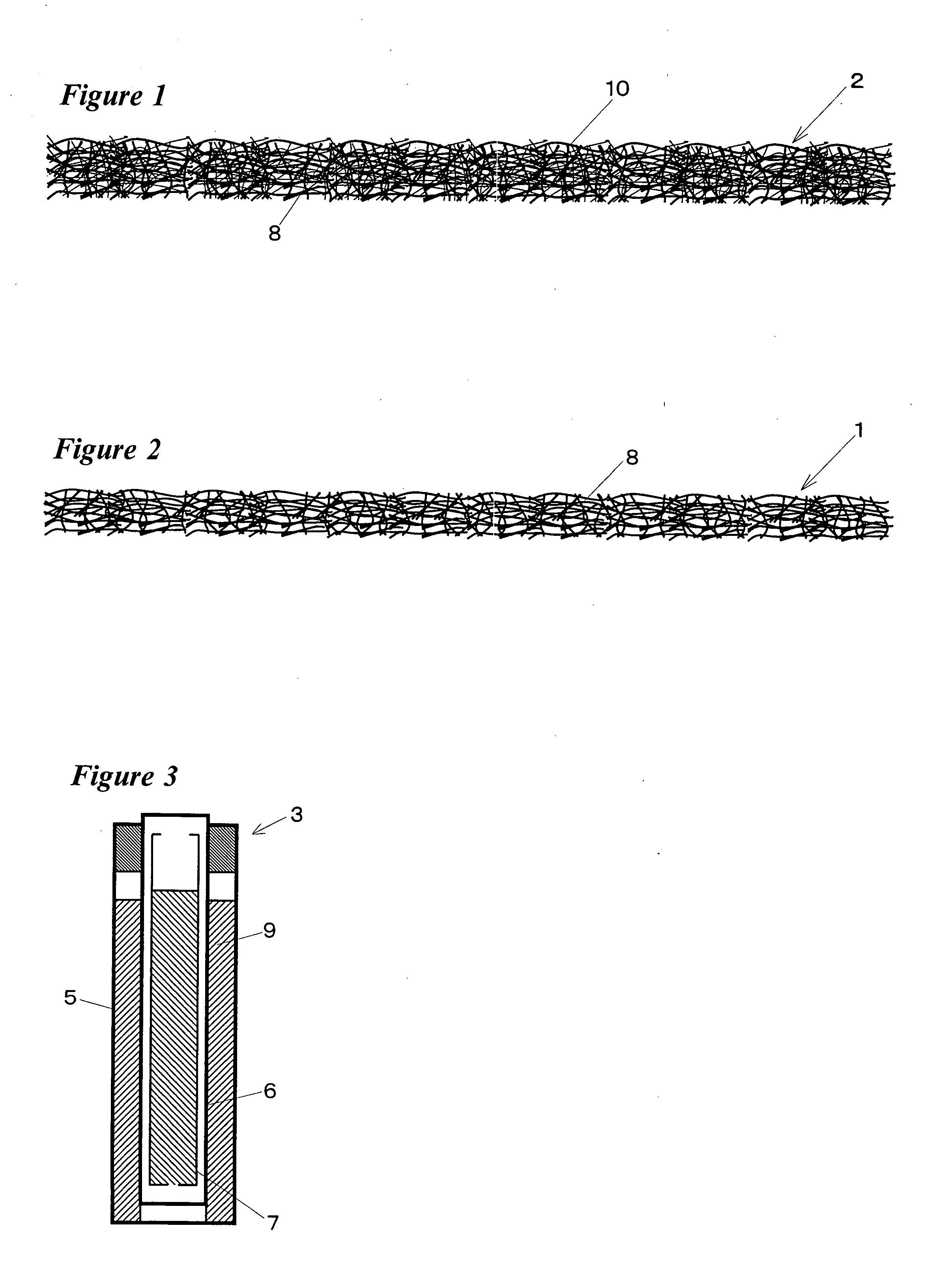Felt Precursor of Electric Conductor for Electrodes and Method for Manufacturing the Electric Conductor
- Summary
- Abstract
- Description
- Claims
- Application Information
AI Technical Summary
Benefits of technology
Problems solved by technology
Method used
Image
Examples
example 2
[0040]With the flame-resistant PAN fiber 8 applied in Example 1, there was mixed 10% in weight of polypropylene staple having a fineness of 7.7 dtex and 32 mm in length to form a lap by carding with a well-known carder. Suitable number of the lap thus obtained was layered and then a felt precursor 2 was prepared by needle-punching from one side thereof. The felt precursor 2 has a density of 0.148 g / cm3 and a degree of fiber orientation of 38%.
[0041]The felt precursor 2 was also baked at about 1600° C. to carbonize the flame-resistant PAN fiber 8 and incinerate the polypropylene staple. As this result, solid of the polypropylene staple was almost transpired and thereby the felt 2 was voided of the staple to yield a felt-type conductor 1 for electrodes. A density of the electric conductor 1 was diminished to 0.099 g / cm3. In the conductor 1, the felt density thereof lowered and pores thereof increased as compared with a normal felt made of a carbon fiber. When the conductor 1 was appli...
example 3
[0042]With the flame-resistant PAN fiber 8 applied in Example 1, there was mixed 5% in weight of polypropylene staple having a fineness of 4.4 dtex and 30 mm in length. By the same treatment as Example 1, there was prepared a felt precursor 2 having a density of 0.154 g / cm3 and a degree of fiber orientation of 33%.
[0043]The felt precursor 2 was baked to carbonize the flame-resistant PAN fiber 8 and incinerate the polypropylene staple. As this result, solid of the polypropylene staple was almost transpired and thereby the felt 2 was voided of the staple to yield a felt-type conductor 1. A density of the electric conductor 1 was 0.101 g / cm3. In the conductor 1, the felt density thereof lowered and pores thereof increased as compared with a normal felt made of a carbon fiber. When the conductor 1 was applied to sodium-sulfur cell, it held much melted sulfur and generating efficiency of sodium-sulfur cell was improved.
example 4
[0044]With the flame-resistant PAN fiber 8 applied in Example 1, there was mixed 5% in weight of polyester fiber having a fineness of 6.6 dtex and 38 mm in length, instead of polypropylene staple. By the same treatment as Example 1, there was prepared a felt precursor 2 having a density of 0.142 g / cm3 and a degree of fiber orientation of 31%.
[0045]The felt precursor 2 was baked to carbonize the flame-resistant PAN fiber 8 and incinerate the polyester fiber. As this result, solid of the polyester fiber was almost transpired and thereby the felt 2 was voided of the polyester fiber to yield a felt-type conductor 1 for electrodes. A density of the electric conductor 1 was 0.095 g / cm3. In the conductor 1, the felt density thereof lowered and pores thereof increased as compared with a normal felt made of a carbon fiber. When the conductor 1 was applied to sodium-sulfur cell, it held much melted sulfur and generating efficiency of sodium-sulfur cell was improved.
PUM
| Property | Measurement | Unit |
|---|---|---|
| Temperature | aaaaa | aaaaa |
| Fraction | aaaaa | aaaaa |
| Fraction | aaaaa | aaaaa |
Abstract
Description
Claims
Application Information
 Login to View More
Login to View More - R&D
- Intellectual Property
- Life Sciences
- Materials
- Tech Scout
- Unparalleled Data Quality
- Higher Quality Content
- 60% Fewer Hallucinations
Browse by: Latest US Patents, China's latest patents, Technical Efficacy Thesaurus, Application Domain, Technology Topic, Popular Technical Reports.
© 2025 PatSnap. All rights reserved.Legal|Privacy policy|Modern Slavery Act Transparency Statement|Sitemap|About US| Contact US: help@patsnap.com


